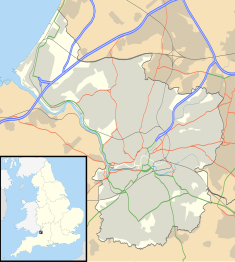Old Council House, Bristol
| Old Council House, Bristol | |
|---|---|
 Old Council House in 2007 | |
| Location | Corn Street, Bristol |
| Coordinates | 51°27′18″N 2°35′37″W / 51.4550°N 2.5935°W |
| Built | 1827 |
| Architect | Sir Robert Smirke |
| Architectural style(s) | Neoclassical style |
Listed Building – Grade II* | |
| Designated | 8 January 1959 |
| Reference no. | 1207433 |
The Old Council House is a building on Corn Street, Bristol, England. It has been designated by English Heritage as a grade II* listed building.[1]
History
[edit]

The site selected for the current building had previously been occupied by three buildings: a medieval council house, St Ewen's Church and the Chapel of the Fraternity of St John the Baptist (also known as the Tolzey).[2] The Chapel of the Fraternity of St John the Baptist was demolished in the late 17th century, allowing an enlarged council house to be rebuilt in the Classical style and completed in 1704.[2] St Ewen's Church was demolished in 1791 and the council house of 1704 and two adjacent properties were demolished in the early 19th century to allow the present building to be constructed.[2]
The present building, which was designed by Sir Robert Smirke[3] in a neoclassical style, was built between 1824 and 1827.[1] The design for the main frontage consisted of five bays with two large Ionic order columns on either side of the entrance.[1] A statue of Justice designed by Edward Hodges Baily was erected on the parapet above the entrance.[4] The interior design for the original section included a large sweeping staircase.[5]

The Council House was extended to the south-west to a design by Richard Shackleton Pope and George Dymond in order to accommodate magistrates courts in 1828-9;[6] this involved demolishing two further properties on Corn Street, the basements of which were reused as holding cells for prisoners.[2] The building was extended again, this time to the north-west, to create a Council Chamber, large enough to accommodate up to 150 people,[5] which was officially opened by Queen Victoria on 12 November 1899.[7] She knighted the Lord Mayor, Herbert Ashman, during her visit.[7]
By the 1930s, the Council House was too small for regular use, and a new site on College Green was proposed: construction began in late 1936 but the works were delayed until after the Second World War, and Bristol City Council was not able to move out to their new premises until 1956.[8]
The old Council House continues to be used as a local register office for registering births, deaths, marriages, civil partnerships and citizenship.[5] Important works of art in the building include a portrait of Queen Anne, painted by the school of Godfrey Kneller in c.1703,[9] a portrait of George II, painted by the school of Charles Jervas in c.1732[10] and a portrait of Queen Caroline, also painted by the school of Charles Jervas in c.1732.[11]
See also
[edit]References
[edit]- ^ a b c Historic England. "The Old Council House and Attached Front Gates (1207433)". National Heritage List for England. Retrieved 1 July 2020.
- ^ a b c d "Old Council House, Corn Street, Bristol". Bristol and Region Archaeological Services. 23 August 2008. Retrieved 10 August 2016.
- ^ Walter Ison (1978). The Georgian buildings of Bristol. Kingsmead Press. pp. 135–139. ISBN 0-901571-88-1.
- ^ Burrough, THB (1970). Bristol. London: Studio Vista. ISBN 0-289-79804-3.
- ^ a b c "The Old Council House: venue hire". Bristol City Council. Retrieved 10 August 2016.
- ^ Mellor, Penny (2013). Inside Bristol: Twenty Years of Open Doors Day. Redcliffe Press. pp. 52–53. ISBN 978-1908326423.
- ^ a b Woodville, Richard Caton (12 November 1899). "Queen Victoria Knighting Herbert Ashman, Esq., First Lord Mayor of Bristol, at the Council House". Art UK. Retrieved 5 August 2020.
- ^ "Council House, Bristol City Council". Art UK. Retrieved 19 August 2018.
- ^ Kneller, Godfrey (1703). "Queen Anne (1665–1714)". Art.UK. Retrieved 5 August 2020.
- ^ Jervas, Charles (1732). "George II (1683–1760)". Art.UK. Retrieved 5 August 2020.
- ^ Jervas, Charles (1732). "Queen Caroline (1683–1737)". Art.UK. Retrieved 5 August 2020.

